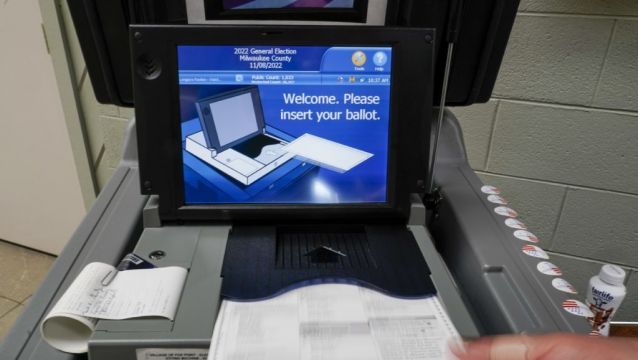Final voting has begun without major hitches in US midterm elections under intense scrutiny after two years of false claims and conspiracy theories about how ballots are cast and counted.
With polls open across most of the country, no big problems were reported early on Tuesday, though there were hiccups in some places, which is typical on any election day.
Vote tabulators were not working in a county in New Jersey and one in Arizona – potentially requiring hand-counting instead – and some voting sites in Pennsylvania were delayed in opening because workers showed up late.

“These are things we see in every election cycle,” said Susannah Goodman, director of election security at Common Cause, a group which advocates for voting access.
“There’s nothing majorly concerning.”
Since the last nationwide election in 2020, former president Donald Trump and his allies have succeeded in sowing wide distrust about voting by promoting false claims of extensive fraud.
The effort has eroded public confidence in elections and democracy, led to restrictions on mail voting and new ID requirements in some Republican-led states and prompted death threats against election officials.
Election day this year is marked by concerns about further harassment and the potential for disruptions at polling places and at election offices where ballots will be tallied.
Election officials say they are prepared to handle any issues that arise, urging voters not to be deterred.

Trouble with vote-tabulation machines at some polling places in Maricopa County, Arizona, generated criticism on social media but a spokeswoman for the state’s elections department said the problem was minor.
“Voters have options,” spokeswoman Megan Gilbertson said. “They can wait to put their ballot in the working tabulator, they can use the secure drop box, or they can go to another voting centre if they don’t want to wait.”
Maricopa is the most populous county in Arizona, a place where elections for governor and US Senate are expected to be close and a state where scepticism of election systems has run deep since 2020.
Before the pandemic, many states had begun to shift away from a single day of voting to offer days or weeks of early, in-person voting and ballots sent through the mail.
No major problems were reported during the early voting period. On Monday, some of Pennsylvania’s largest counties scrambled to help voters fix mail-in ballots which had flaws such as incorrect dates or missing signatures on the envelopes used to send them in, bringing about confusion and legal challenges in the battleground state.
Heading into Tuesday, nearly 44.5 million people across the country had already cast ballots.

Party affiliation seems to be an increasing factor in how and when people vote. Republican scepticism of mail voting has persisted amid the attacks by Mr Trump and his allies. Some Republican activists and candidates have gone so far as to encourage voters who receive a mailed ballot to wait until the very last minute to turn it in, claiming it will somehow prevent Democrats from stealing the election.
There is no evidence of widespread fraud or manipulation of voting machines in 2020. Exhaustive reviews in states contested by Mr Trump all affirmed President Joe Biden’s win, while dozens of judges, including ones appointed by Mr Trump, dismissed numerous cases making unsubstantiated claims of wrongdoing.
Election officials have defended the system. They note the many checks in place to ensure only one vote per person is counted, the reviews that ensure machines accurately count ballots and the efforts to identify any fraud attempts.
“State and local election officials have contingency plans in place so voters can have confidence in our elections,” the National Association of Secretaries of State and the National Association of State Election Directors said in a statement.
But the false claims have spread widely among Republicans, fuelled by conspiracy theorists on social media and at events held across the country.
An Associated Press-NORC Centre for Public Affairs Research survey from October found 45% of Republicans had little to no confidence that votes in the midterm elections will be counted accurately. And a majority of Republicans, 58%, still believe Mr Biden was not legitimately elected — though it’s down slightly from 66% in July 2021.

Election officials acknowledge electronic voting systems can be vulnerable and have taken numerous steps to increase security since the 2016 election, when it was determined that Russia looked for vulnerabilities. Congress has sent nearly 900 million US dollars (£776.4 million) to states to boost their cybersecurity defences, including hiring more IT staffers, replacing outdated systems and adding regular security testing.
Most voters also cast hand-marked paper ballots or use machines that produce a paper record of their votes. These are used after the election to check that machines used to count ballots work properly.
Ahead of the election, Republican and conservative groups recruited people to serve as poll watchers and to get hired as local poll workers. Fuelled by the lies about the 2020 election, some people even stationed themselves near ballot drop boxes in Arizona while toting guns, wearing body armour and concealing their faces with masks. Just last week, a judge ordered such groups to keep at least 250 feet away.
Since the 2020 election, false claims have led to a wave of harassment and death threats targeting election officials and staff. That has prompted some to leave the profession altogether, a loss of experience that has added to the challenges of conducting a smooth election this year.
Election officials have promised they will not hesitate to contact police to protect voters and poll workers. A coalition of voting rights groups has volunteers available to assist any voters who run into problems on election day, staffing the 866-OUR-VOTE hotline.
Once polls close, results will start being released. Different rules and ballot deadlines will mean some states will be faster to report than others.







